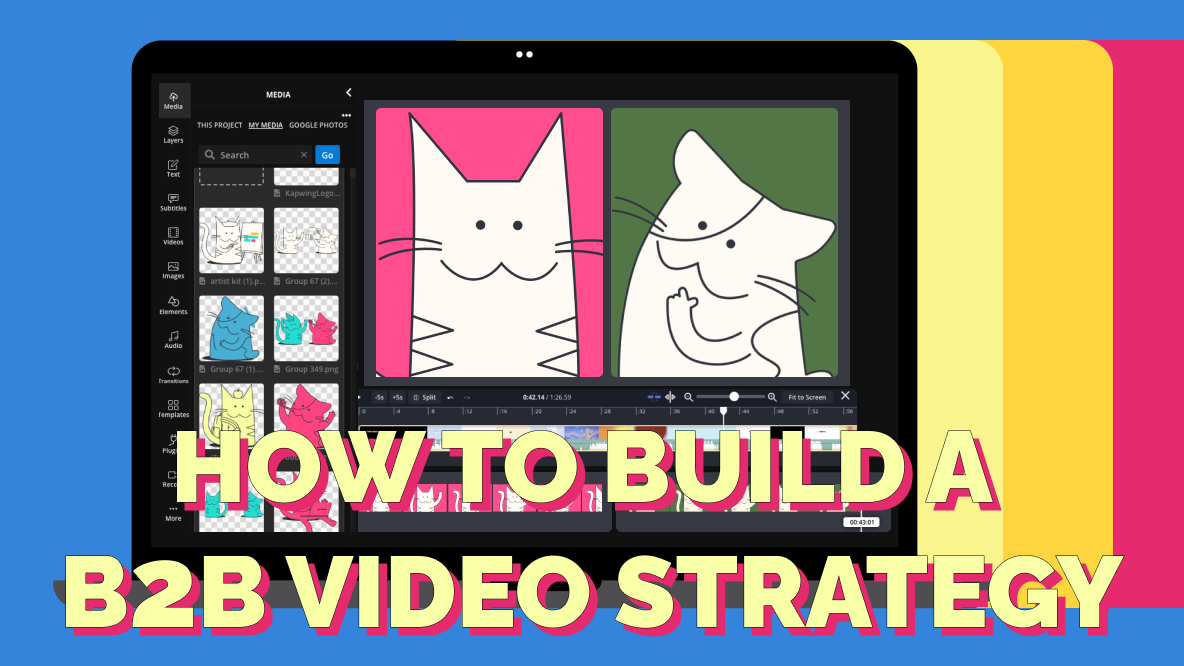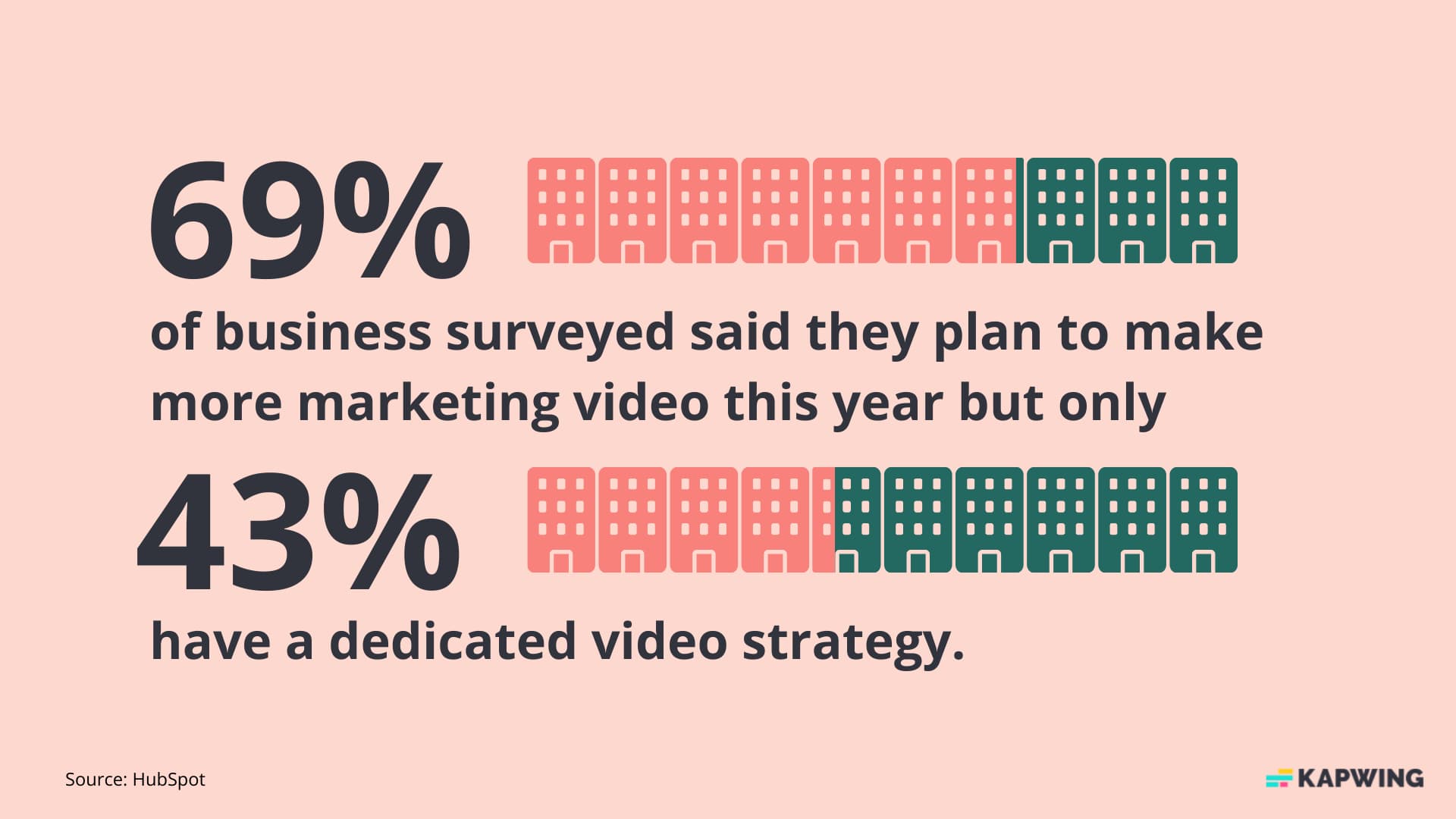How to Build a B2B Video Marketing Strategy (Plus and Inside Look at Our Own Video Strategy)
Should your brand have a video marketing strategy? Take an inside look at Kapwing's own B2B video strategy and how we use video to support our overall content marketing and business goals.

There's been a lot of ink spilled on the importance of video in B2B marketing. We've added to discussion, too, and firmly believe video should play a significant role in every content team's strategy—and should even be the anchor medium for most teams.
But what does that actually look like?
Rather than offering armchair analysis, we're going to unpack our (current) use of video across our content marketing efforts. We'll share our goals with content, how video supports those goals, and the content mix we're currently using and why.
Transparent and practical examples are way more useful than abstract theory, but first, a quick disclaimer: We don't claim to have video fully figured out. We're students of great video marketing and just sharing what we've learned.
Do you really need a "strategy" for video?
This might seem like an obvious question to start with, but it's worth unpacking.
Video affects so many marketing efforts that some companies, especially larger ones, could hardly claim to have a unified "video strategy." In fact, according to HubSpot’s 2023 State of Marketing report, only 43% of companies feel they have a video strategy.

Of course, that’s not to say that the other 57% of companies aren’t making video. It's more that video tends to show up as part of the strategy for most marketing teams or initiatives, rather than its own initiative.
For content teams, this question is a bit more interesting. Content teams decide on formats based on their overall strategy, which is itself informed by things very unique to the business, like the customers they serve, the current marketing objectives, and so on.
Despite the (honestly, deserved!) hype around video, content teams should be cautious of leadership pressure to create a video strategy. This can lead to just creating video content for the sake of it, rather than to forward any specific marketing or business goals. Instead, we recommend creating a content strategy (or a broader marketing strategy) that outlines specifically where and how you’ll use video – and, perhaps more importantly, why video is the best medium for those purposes.
“We should do video” is maybe the worst reason to do video.
Building content strategy objectives with video at the forefront
That brings us to Kapwing.
To give you a peek behind the curtain, Kapwing doesn’t have a “video strategy.” Shocking, we know. We’re a video software company, after all!
Rather, Kapwing has a marketing strategy, mostly powered by content, much of which is video. It seems like a distinction that is mostly semantic, but we believe it’s an important difference because the strategy informs the content format, not the other way around.
And what we want our content to do is as important as where and how we distribute that content.
In our content strategy, for example, we rely on SEO and tools pages to capture existing demand. We know someone searching for “automatic subtitle generator” has a clear and present need for an auto-subtitler. They find our subtitler tool page and voilà, our product can meet the demand.
Because these pages are so effective at this job, we rely on video mostly to create demand, rather than capture it.
Here’s how we do that.
1. Start with a key narrative
Our content strategy is guided by Key Narratives that share Kapwing’s points of view on how video marketing works and where things are headed, things we want our prospects to believe about video creation.
We share these POVs for two main reasons.
- We have unique, solid insight into the video creation industry and we believe that we can help content marketers be more successful with video.
- We know that prospects who share our opinions about the industry or some specific video creation problem will more clearly see the value of our product.
2. Strategically distribute
Video is a great vehicle for these kinds of messages because it has some of the best reach of any content format currently. Nearly every social media channel is prioritizing video content, users are more likely to consume and share video content, and video is by far the most personable format, which is helpful when your goal is to change beliefs and behaviors.
We develop video content ideas that tie back to our key narratives and publish on multiple channels in multiple formats.
Here’s an example of how we’ve explored a single topic across multiple channels and mediums:
More on our specific content split in a moment, but you can see that one idea generates at least five separate pieces of content.
3. Measure and optimize reach
Platform-native video content is much harder to measure than something like paid search. It often weighs last touch attribution too heavily and gives a lot of the credit to Google. It’s the reason many marketers are leaning into the concept of dark social and looking for new methods of accurately analyzing and attributing reach and conversion.
At Kapwing, we rely on tools like self-reported attribution to determine where people are hearing about Kapwing first. We track our success by whether or not specific social or video channels grow or decline in their approximate contribution to Product Qualified Leads or signups that fit our ideal customer profile.
Of course, this isn’t a perfect way to measure success. You never want to rely too heavily on any metric that only accounts for one phase of the customer journey. Which is why we also look at more operational metrics, like social analytics.
Yes, views and impressions do matter, you just need to pair them with something deeper in the funnel.
With this mix, we can keep our finger on the pulse of how our content is performing and whether it’s driving the results we want to see. If something looks off, we adjust. If things look great, we double down.
B2B video marketing breakdown: the content mix we rely on
Let’s take a look at Kapwing’s own content mix as a case study for how to build a B2B content strategy around key narratives with video as the primary content engine.
Here are our 5 key content formats:
1. Video Podcast
We settled on creating a video podcast as the best way to unpack our key narratives and cover our points of view in depth. We also bring in outside perspectives with guests who add color and new view point to our take on things (and give us access to that valuable resource, OPA–other people’s audiences–when they share their featured episode on their own channels).
This podcast, The Shortcut, is our anchor medium: the content format where our big ideas make “first contact” with our audience. But that’s only one aspect of what an anchor medium does.
So, the show itself is just the beginning. We then lean heavily into
- Content repurposing: pulling and resizing clips for social media, and
- Content atomization: creating net-new content from the same ideas, but not the same exact footage or material.
Speaking of content atomization…
2. Atomized Editorial Content
This is technically a few different content formats in one, but the general idea and execution are the same. After exploring a topic on the podcast, we’ll turn it into several pieces of editorial content: a blog post for our Resources Library, an email for our newsletter, a takeaway post for social channels.
By doing this, we’re accomplishing a couple of things: 1) reaching audiences we might have missed with the podcast (some people still prefer blog posts!) and 2) ensuring that wherever you encounter Kapwing, you’re getting exposure to the same ideas.
3. Made-for-Social Video
In addition to the video content we repurpose for social from our anchor show, there are a few other formats we use for social channels.
For example, social media is a great platform for experiments. Make it for social first and then if it does well, make a long-form version. Jack Dodge, our Video Content Strategist, often runs experimental content on our Shorts, Reels, and TikTok channels.
Recently, as a bit of pre-marketing for the launch of Kapwing’s new AI text-to-speech voices, he created this video, to see if viewers could guess which voices were AI and which were our flesh-and-blood team members.
There was no clear consensus among the commenters, which was a pleasant surprise. We actually included the video in our press release about the new feature as evidence pointing to the high quality of the voices.
Other social-first formats we create short-form video for include product demos, often to show off our new AI features, and explainer videos, distilling big ideas down into quick, bite-sized content.
4. Founder Brand
Another area where our key narratives get exposure is the personal LinkedIn account of Kapwing’s CEO and co-founder, Julia Enthoven.
Executive social media, or as we call it internally at Kapwing, Founder Brand, is a way to expand your brand’s audience. It’s well-documented how much extra reach a personal account on LinkedIn gets over a company page, but it still feels a little shocking when you look at the actual numbers.
We could spend hours and hundreds of dollars creating the best content for our company page and it would see a quarter of the views and engagement of a video our CEO made on her phone and posted to her page. Maybe less.
To capture some of this reach, we pitch Julia thought leadership topics, asking for her take and insights into the same ideas and narratives we unpack on other channels. We also set aside dedicated time to record videos of her talking through these topics. We’re lucky to have a hands-on founder with as much experience and insight into the industry as she has, so we absolutely leverage that wherever possible.
5. YouTube Product Videos
In addition to the channel where we host our video podcast, Kapwing also has another YouTube channel, used primarily for product videos: in-depth tutorials as well as product announcements.
With our tutorials, we try to solve for specific problems that we know users are searching for (capturing demand, not creating it). These videos typically sit at around the three to five minute mark and include detailed screen recordings to walk viewers through how to create audio waveforms or add automatic subtitles to a video.
For product announcements, we provide a clear product demo of the new feature as well as examples of common use cases.
We don’t just hit publish on YouTube and call it a day, though. Remember, these videos help capture demand, just like our tools pages. To add additional value to our tools pages (as well as help our pages surface on Google as video results in addition to the regular SERP), we embed many of our YouTube product videos onto product and tools pages across our website.
📚 Learn more: How to Use YouTube for B2B Marketing
How to build your own B2B video strategy
If you feel compelled to have a solid “video strategy” for your B2B brand, consider incorporating it as a part of your content marketing strategy at large instead. You can even call that slide in the Google presentation “Video Strategy” if you need to.
The trick is to figure out what you’re trying to say, first, then decide where and how you want to say it. And, as you can see from the breakdown of our own content mix above, there are a million different ways to do video. Find the ways that are right for your brand – and your brand’s key narratives.
☝️ Check out the latest episode of our podcast for more insight into how Kapwing builds our B2B video marketing strategy.
Create content faster with Kapwing's online video editor →








